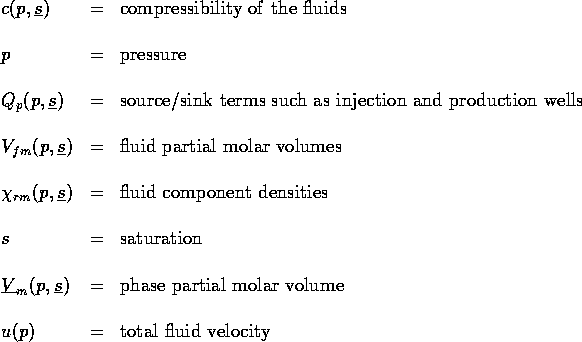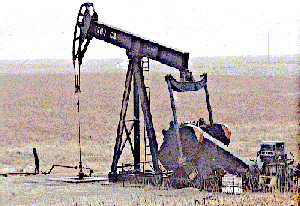|
RELATED
WEBSITE:
Emeagwali's
Website
|
Petroleum engineers use the flow pattern within a reservoir to
decide where to drill a well, how many wells should be drilled,
how to maximize the production from a group of wells, and how and where to apply enhanced oil recovery techniques.
An example of a complex reservoir simulator is
the Multiple Application
Reservoir Simulator (MARS)
code developed by Exxon Production Research Company and
described in reference.
Some of the governing partial differential equations used
in the MARS code are the
pressure equation and saturation equations


respectively, where,

In the above equations used in the MARS reservoir simulator, the pressure
distribution, p(x,y,z,t), in the pressure equation
is differentiated to obtain the
total fluid velocity distribution which, in turn, is used in the saturation equations. The few instances in which it is not require to differentiate
the pressure distribution is when certain least squares or Galerkin finite element approximations of the parabolic equations are used. Unfortunately,
existing production codes are based on finite difference techniques. Since
the development of these codes are based on decades of man-years
the best approach is to use the Fillunger-Risenkampf's since it allows the modeler to reuse the existing codes by reencapsulating the new equations.
However, with the new porous media flow governing equations
proposed in this work, it will not be necessary to compute the velocity distribution
since it will be explicitly available from the
solution of the governing equations.
Second, Dirichlet type boundary conditions are more accurate than Neumann type
in the vicinity of injection and production wells.
Third, the governing equations will still be valid when the Reynold's number is
high near the injection and
production wells.

The governing equations
for this oil drilling site
will be those representing the governing laws for
oil, gas, and
water.
Factors that increase the computation-intensiveness of reservoir
simulators include accounting for the thermodynamic and chemical
relationships for water, hydrocarbon liquid and hydrocarbon gas phases
and accounting for the mass
transfer between the liquid and gaseous phases, which occurs
from carbon dioxide injection and volatile oil.
For example, an IMPES black-oil simulator has five computation-intensive segments. The first and largest portion
solves the linear systems of equations approximating the governing equations. Solving these equations consumes 35 to 50 percent of the
total execution time. The second segment generates the coefficients and consumes 30 to 40 percent of the total execution time. The
third looks up a table to determine the relationship between
two functions such as water
saturation
 and
the water relative permeability and
the water relative permeability
 .
These relationships are expressed in tabular form for finite values.
Therefore, the exact relationship needed must be determined by interpolation. .
These relationships are expressed in tabular form for finite values.
Therefore, the exact relationship needed must be determined by interpolation.
Table look-up operations consume 15 to 25 percent of the total execution time.
Finally, the initialization and input/output
operations consume about 10 percent and 2 percent, respectively, of the total execution time. An interesting observation is that by using
the proposed complete hyperbolic equations in the reservoir simulator we make the most computation-intensive segment of the simulator to become the
least computation-intensive segment which is both good and bad news.

Click on emeagwali.com for more information.

©1997. EMEAGWALI.com. All rights reserved.
|
![[Philip
Emeagwali]](../../gifs/Emeagwali_Reservoir_Equations.jpg)

![[Philip
Emeagwali]](../../gifs/Emeagwali_Reservoir_Equations.jpg)
